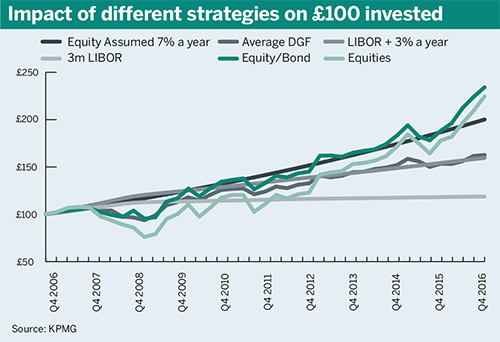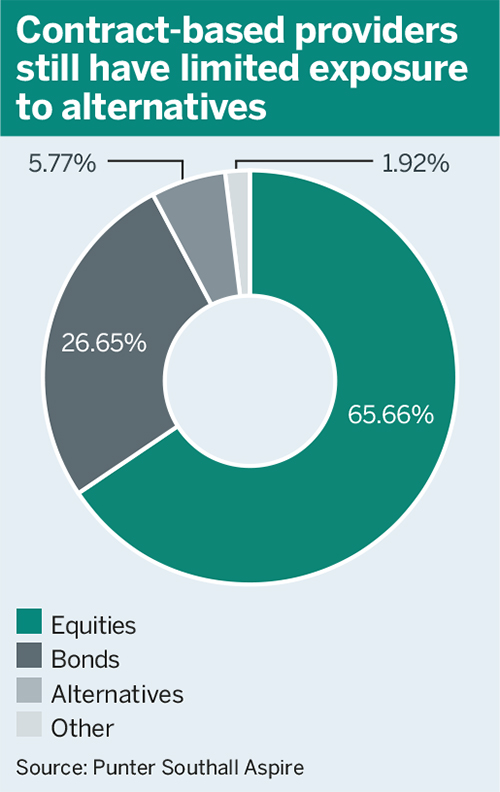In the second part of this quarter’s debate, our five DC professionals look beyond the traditional bond and equity portfolio to consider issues including diversified growth funds, alternatives and ESG.

Do DGFs and absolute return funds deserve their recent criticism?
Jon Parker: In short, yes, and responsibility should be shared across industry participants.
Many of the return targets set by funds in this sector were unrealistic based on their investment strategies. The appeal of ‘equity-like’ returns with lower risk is understandable, but expectations needed to be better managed.
In some respects, their timing has been unlucky, coming as it has during the record-breaking 3,453-day/$18tn (£14tn) bull run in US equity markets, coupled with low volatility.
However, memories of why these funds first became popular seem to be fading. Many defined contribution defaults used to invest wholly in equities and consequently suffered during the dot-com and global financial crashes in the 2000s.
Criticism of diversification and dynamic asset allocation tends to be a ‘late cycle’ thing as investors are encouraged by a long bull market to be ‘risk on’
Alistair Byrne, State Street Global Advisors
Diversification away from equities was an understandable and sensible reaction. If (or when) the next correction happens, we would do well to remember this.
Andy Cheseldine: Another short answer, and again it is (often) yes. Those equity-like returns were sold as being perhaps 1 to 2 per cent lower – but with half the volatility.
The exact metrics varied but the overall story was broadly the same. Actual performance has often been significantly poorer and at a significant cost in terms of active management fees (and sometimes transaction costs).
However, I do not think that means we should all exit the DGF/ARF market. One of the reasons they look a bit poorly is a consistent and powerful bull equity market over the past decade combined with persistent low long-term interest rates.
Those factors may continue to dominate for another decade, but do you really want to bet your retirement on it?
What we can and should do is keep monitoring the managers to ensure they stick to their brief and do not increase the risk in their portfolios by trying to play ‘catch up’ with their competitors and the rest of the market.
John Reeve: I suspect that the big test for these funds is yet to come. Their ‘holy grail’ promise of equity-like performance with reduced downside risk has always been something that looks like a marketing ploy as much as an investment strategy. Indeed the name “absolute return fund” suggests to many a form of guarantee.
I think most inexperienced savers would expect that these funds would guarantee not to fall and may even have a guaranteed “absolute return”. They may be in for a shock when the next crisis hits us.

For many of these funds meeting their objectives will require them to “call the market” and move money at the right time. History suggests that managers are not necessarily good at this.
To my mind a DGF is just another form of managed fund with different objectives and constraints (often fewer than a traditional managed fund) and often higher charges.
Schemes should therefore ask themselves whether they believe in active management. If they do then it may be that DGFs, with a wider range of choices, are the right funds. However, if you do not then a passive approach with lower fees makes more sense.
Another question is whether the charges of the fund are justified by the likelihood of higher returns? These funds do tend to have higher charges and the move to more transparency on costs will help savers understand this. Whether those charges are justified, only time will tell.
Helen Ball: With hindsight, it is always easy to claim that you would have acted differently. The problem with the performance of such funds more recently is that they have not really been tested in the circumstances they were intended for.
What they have set out to do is to achieve a targeted level of return within a smaller corridor of risk and we understand that is what they have achieved in many cases.
You need to balance against that the cost of doing so which, in the light of current trends of focusing on cost transparency, is perhaps why they have fallen more under the spotlight.
They have perhaps not looked so good compared with simple trackers that have roared away because the market has done well. To test them properly, we need to look at their performance after a market crash and see if they do what they have promised then.
Alistair Byrne: Undoubtedly some deserve criticism. There are clear benefits from diversification across a range of asset classes, but the benefits from active asset allocation have been more mixed.
It is worth noting that market conditions have been favourable for a while since the financial crisis, with strong equity and bond returns – meaning diversification and dynamic asset allocation have not had much opportunity to show their worth.
Their value will be more evident in more testing times. Criticism of diversification and dynamic asset allocation tends to be a ‘late cycle’ thing as investors are encouraged by a long bull market to be ‘risk on’.
Do illiquid assets have a role to play in DC portfolios, and how can we get around the daily liquidity problem?
Byrne: Yes – younger DC members are by definition long-term investors and can potentially take advantage of the illiquidity premium to grow their pot.
We have relatively high certainty that members will not need to access their assets for many years, though perhaps less certainty about when they will want to switch providers.
Illiquid investments pay off where the returns from the illiquidity premium and manager skill exceed the higher management costs.
The potential temporary illiquidity is a tiny price to pay in comparison with the potential for increased long-term returns
Andy Cheseldine, Capital Cranfield Trustees
However, it is worth noting that index management of listed assets now costs very little, and many illiquid strategies do come with high fees that eat into the benefits.
The best way around the daily liquidity problem is scale. Large numbers of members make cash flows more predictable and units can be recycled from one cohort of members to another, as happens in Australian super funds. In practice, illiquid assets will also be only a minority of the portfolio allocation, say up to 20 per cent.
Ball: Ideally illiquids should feature, but this would depend on the investment strategy of the trustee and the size of the scheme.
It seems there is a willingness to be more inclusive in terms of the strategy offered by some DC schemes, but the desire to make available a daily switching cycle from platforms has driven a wedge between illiquid assets and DC members.
People are becoming more open-minded about this however, and it may be that we will see such investments in the future.
Reeve: Key to resolving this is to remove the requirement for daily pricing and to manage cash flow in a more sophisticated manner.
As one new pensioner put it to me recently: “They knew 65 years ago when I would take my pension, why does it seem such a surprise?”
Even those who do not retire at their normal retirement age rarely do so at very short notice. Most take months to make a decision and most only take a small payment. Better planning of cash requirements could mean that we can move away from daily pricing entirely.

Given the low-return world that we seem to be experiencing at the moment, and which seems likely to continue, the extra return that can be earned from illiquid assets looks even more important. The economy should also benefit from investment in these projects.
It should not be beyond our collective ability to find a way of creating some form of liquidity fund within a DC investment vehicle or insurer to help manage expected cash flow.
Parker: The opportunity for DC pensions to take advantage of a broader range of investment opportunities should be cautiously welcomed.
The challenges of accessing illiquid assets are well documented – they include some that are regulatory (such as the Financial Conduct Authority’s permitted links rules), some operational (daily pricing and dealing requirements of many pension platforms) and some scale-related (high minimum investment amounts).
Notwithstanding these challenges, as many DC schemes are cash flow positive it should be possible to build up allocations to illiquids over time, and as part of a balanced portfolio, any redemptions can be relatively easily managed.
The risk/return profile of illiquid assets is inherently attractive for long-term savers and many of them are naturally income-generative.
Perhaps the more significant hurdles are around competition and charges. The demand for high quality illiquid assets is significant and in the UK includes overseas pension schemes (for example, the Ontario Teachers’ Pension Plan owns stakes in a number of UK airports).
It will be difficult for relatively small DC schemes to compete with large pools of institutional money from domestic and overseas buyers.
The introduction of illiquids to a DC portfolio is also likely to be more expensive than existing assets – those costs may have to be passed on to members.
Cheseldine: A typical new entrant to pension saving is age 22 following auto-enrolment. Someone that age will probably not be able to access their state pension until they hit their mid-seventies.
If you are saving into a fund that will not be accessed for more than 50 years, surely you should try to make use of all the advantages you have – including illiquidity premia.
So, in many ways DC funds should be more heavily invested in illiquid assets than defined benefit.
I think it is clear that we need to differentiate between daily pricing – required to avoid arbitrage between investors who might otherwise be tempted to play the market, and to facilitate the many DC communication tools now offered – and daily dealing.
The latter is basically unnecessary. Daily dealing should not be needed when we are considering 50-year investments. The potential temporary illiquidity is a tiny price to pay in comparison with the potential for increased long-term returns.
Should DC default funds take into account the views of their members when setting their approach to ESG?
Should DC default funds take into account the views of their members when setting their approach to ESG?
Reeve: Yes – it may be that one of the best ways of getting the younger generation engaged with their savings is to help them understand what their money is doing.
There is no doubt the new generation of savers has different priorities. More and more we are seeing savers who are keen that their savings should be ‘doing good’ as well as getting a good return.
Member views are not the determining factor here but they are becoming an increasingly important element of the trustees’ review of their investment strategy
Helen Ball, Sackers
Indeed, there is some evidence that they would be willing to give up some investment return if their money is invested for good.
Given this it seems totally appropriate, indeed necessary, for default funds to take account of member views. The question is how to do this.
Trustees should have an understanding of their membership and need to create a mechanism to do this. Indeed, the Pensions Regulator’s DC code requires this.
They can then use this information to help inform the choice of investment or of fund manager.
Cheseldine: Regulators tell us we must take into account member views. But the crucial point about ESG-led investment strategies is that they are financial strategies aimed at producing better, less volatile, long-term returns for investors.
They are not ethical strategies other than by pleasant coincidence.
Therefore we need to be very careful in how we phrase questions to members to ensure that we really understand their answers.
That is not to say we should patronise them. Sometimes the non-expert member, just like member-nominated trustees, will ask the pivotal “why” or “why not” question that makes us fundamentally reassess our approach.
For instance, if it became clear that the younger generation were all boycotting the tobacco industry at the same time as the older generations were suing them, that would be a fairly obvious indicator that it is not a great industry where we should be overweight in investment terms.
Ball: Member views are not the determining factor here, but they are becoming an increasingly important element of trustees’ review of their investment strategy, particularly in the light of the proposed changes to investment decision-making that are due to come into force in October 2019.
It will perhaps work best when all members are likely to think in a similar way (not necessarily the case in all schemes).
In a more general sense, it can be helpful to consider the ESG interests of members because they are more likely to see that they are getting ‘value’ if the opportunities offered to them by the scheme tie in in some way with their own expectations and beliefs.
Having said that, ESG is not simply about focusing on members’ views but taking into account other financial factors relevant to the performance and expected return to be paid out by a company in the future. Ultimately, the heart of the trustees’ responsibility is to maximise investment returns on behalf of their scheme’s members.
Byrne: We think it is better and clearer to think about ESG investment as taking account of material financial risks that arise from ESG issues.
This is entirely consistent with trustees’ fiduciary duty and indeed is a core part of their role. Members’ views may be helpful in identifying issues, but confusing ethics and risk management has tended to be a barrier to effective incorporation of ESG investing in a trustee context.
That said, the recent Department for Work and Pensions consultation and Law Commission report sets out a helpful framework for incorporating member views – that the view must be widely held and that taking account of it is not likely to cause material financial detriment.
Parker: If the DWP’s updated regulations are implemented broadly as drafted, trustees would have the option (rather than the obligation) to seek member views, subject to a two-stage test.
For contract-based plans, the FCA’s 2018/19 business plan states that it will look to expand the remit of independent governance committees with a view to following the Law Commission’s recommendations on social investment, although the timing of this has been challenged due to Brexit priorities.
Finally, an even stronger steer on ESG and member views is being discussed at EU level within proposed future amendments to IORP II (which comes into effect next January).
This includes proposals for much greater disclosure of how climate change risk is managed and a requirement that pension schemes “must consult with their beneficiaries when deciding what investment strategy is in their best interests”.
Putting to one side the regulatory activity, is there a wider groundswell of opinion among DC members to have their beliefs reflected in how their pension assets are invested?
Despite research suggesting strong public interest, this does not yet appear to have crystallised into DC members proactively asking questions of their trustees, employer or IGCs.
And governance bodies should absolutely not be taking investment decisions based on the views of a minority of vocal members, however well-intentioned.














